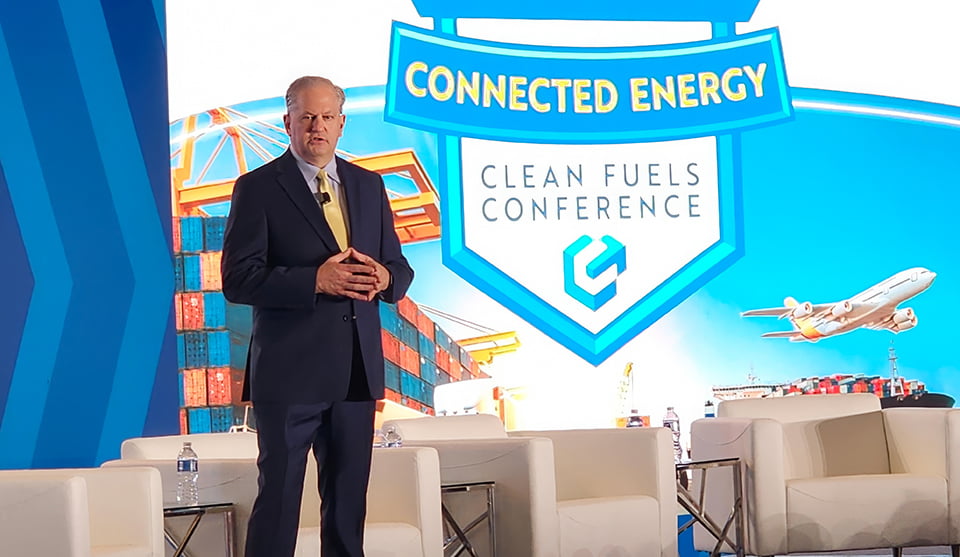
(Photo: Iowa Soybean Association / Aaron Putze)
Biodiesel proponents will succeed because they are true believers
March 7, 2024 | Aaron Putze, APR
Those expecting clarity on guidance for Sustainable Aviation Fuel (SAF) tax credits while attending Commodity Classic last week in Houston returned to their farms and homes disappointed.
In his remarks to a record number of classic attendees during Friday’s general session, U.S. Ag Secretary Tom Vilsack said the administration was not ready to announce the much-anticipated news on SAF tax credits for 2022-2024 and 2025 and beyond.
Instead, the department will delay for at least “a few more months,” said the former Iowa governor and Mt. Pleasant mayor.
“We’re committed to measuring twice and cutting once,” he said.
Or, to put it another way, getting the guidance right rather than right away.
No matter the reason, the lack of clarity on the tax credits for SAF left farmers and biofuels advocates gathered in Houston disappointed.
It’s not the first time.
Those committed to moving more gallons of fuel made from homegrown feedstocks like soybeans are accustomed to being let down. Volume obligations put forth by the Environmental Protection Agency too often lag behind the realities of production striving to keep pace with skyrocketing demand.
But like anything worth doing and having, biofuels proponents and those who need the drop-in fuel to achieve aggressive carbon reduction goals will persevere.
That’s because there’s no other option. The other is that biofuels proponents are optimistic by nature and true believers in the fuel’s here-and-now benefits.
The glass-half-full mentality is a direct result of representing an industry that was created by farmers using their hard-earned soybean checkoff investments. The resolve isn’t surprising, given that plenty of steadfastness is also needed to be a farmer.
This unbridled enthusiasm and a never quit attitude were on display during Clean Fuels Alliance America’s (Clean Fuels) 20th annual meeting held recently in Fort Worth.
“Companies are looking for low-carbon energy solutions now,” said Clean Fuels CEO Donnell Rehagen. “We’re ready for prime time and to assist them in their journey.”
The reason for optimism is back by demand for the homegrown fuel. Biodiesel use exceeded 4 billion gallons last year and is expected to grow to 6 billion by 2030.
“It feels like the world is ready to meet us in this vision because companies must evolve and adapt to be more sustainable,” he added. “Our paths have finally crossed in a way that we always thought they would – seeing us as the low carbon future that works in the existing infrastructure.”
The true market potential of biodiesel, renewable diesel and SAF are enormous. Some peg the amount at 45 million gallons. In addition to aviation, rail, marine and home heating are also growth markets for the drop-in fuel.
Biofuels proponents say the evolution of the industry is driven by consumer demand. Companies are expected to commit to carbon reduction pledges. Consumers and NGOs are watching and holding them accountable.
“We fit right into this commitment,” Rehagen says. “Soybean farmers have funded this vision, to prove our fuels, working with automakers and working through federal and state policies – biobased fuels are today the solution we always thought they would be.”
Despite facing headwinds created by EPA’s inadequate biofuels blending obligations, the industry’s leaders continue to take a proactive approach to moving the industry forward.
They point to growth in biofuels volume obligations for 2024 and 2025. The fact that they are in place provides certainty in an otherwise highly uncertain industry. And, biofuels proponents believe the marketplace will adjust to the new realities of biofuels production and demand.
“Markets always tend to right themselves and, in our industry, they almost have to as demand is so high,” said Rehagen. “Markets respond when demand and supply grow. That growth provides opportunity in the marketplace.”
Clean Fuels says it will redouble efforts to build awareness of the low-carbon value of biofuels. Fuel producers, distributors and customers will be encouraged to share the true value of the fuel beyond its economics. This includes increased demand for soybeans benefiting farmers and rural communities and the many health advantages to cleaner air, particularly those living in densely populated metros.
“The carbon reduction value for our fuels will never go away, but get better in the coming years,” said Rehagen. “We must understand the true value of our fuels and market them accordingly.
“Let’s not give away our own ‘imaginuity.’ Now is not the time to hunker down and wish for the good ol’ days but to press ahead to what will be new good days.”
As proof, there’s more biodiesel and renewable diesel being consumed in California than diesel fuel. Soy-based biodiesel now makes up more than 60% of California’s entire diesel pool.
“That’s pretty outstanding, and most expect it will be nearly 100% in the next few years,” said Rehagen.
“This success is a direct result of the soybean farmer and biodiesel industry,” he added. “We must always keep that spirit of resiliency because we are making a true difference in the world.”
Putze serves as ISA Chief Officer of Brand Management and Engagement. He can be reached at aputze@iasoybeans.com.
Back